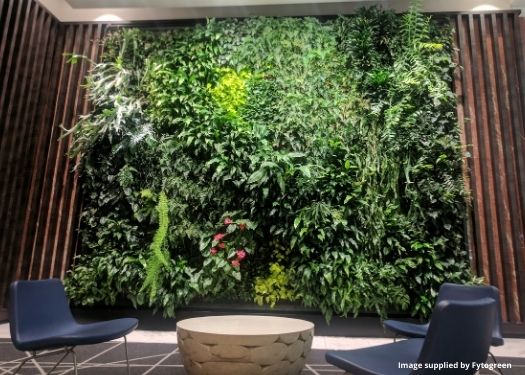Are vertical gardens hard to maintain?
Whether you are thinking about a vertical garden at home or in the workplace, it’s important to understand the time and effort needed to maintain a vertical garden and the tasks you will need to carry out on a weekly, monthly and yearly basis in order to maintain a healthy and vibrant vertical garden.
The first thing to consider is whether the vertical garden is an interior or exterior system. The size and scale of your vertical garden will be a big contributing factor to the amount of time you will need to dedicate to maintaining the plants and automated hydroponic system that make up the composition of your vertical garden.

Typically, vertical gardens are easier to maintain than a regular garden, or other types of green wall such as a rooftop garden. Many interior solutions can be maintained without the need for ladders, so working at eye level can be easier than bending down. The fact that your plants are in containers also makes it much easier to deal with pests, disease, and even weeds which can all be time-consuming elements of maintaining a regular garden.
All vertical gardens require an automated watering and feeding system which are called hydroponic systems. While larger vertical gardens will obviously take longer to maintain the key point in vertical garden design is to use plants that are easier to maintain. This starts with using plants that are ideally suited to the conditions that the host wall will expose the plants to.
What are the typical maintenance tasks for a vertical garden?
Depending on the plants that you choose and the location of your vertical garden, there are maintenance tasks that need carrying out on a daily, weekly, monthly, and yearly basis. Some of the main tasks you will need to complete include:
- Irrigation adjustment
- Replenishing nutrient supply
- Pruning
- Dealing with pests and disease
When you are thinking about maintenance, it’s important to consider a number of factors when first installing your vertical garden and here at SRS, we work with a very experienced, tertiary qualified, botanist so as to provide a planting plan, using only plants best suited to the location and expected exposures of wind and sun. Matching the plants to the location of your garden will determine how easy it is to maintain your vertical garden.
The challenges of maintaining a vertical garden
We have already talked about some of the tasks involved with maintaining a vertical garden above, and each of those maintenance tasks come with their own challenges. Let’s take a closer look at some of the challenges with each of those elements:
Watering and fertilising
All vertical gardens require automated irrigation and feeding and the maintenance procedures covers adjusting the irrigation events and times for each seasonal change. SRS vertical garden system design is based on many years of research so as to ensure all parts of the vertical garden get the same amount of water. This means we have full control over the entire wall for watering and feeding. By using a drip line for applying water this reduces any water loss from the system.
Pruning
As with every other aspect of maintaining a vertical garden, the amount of pruning needed will depend on the type of plants you select for your garden.
With hydroponics, you control the growth rates of the plants with the number of nutrients added. Despite this, when plants get to maturity many species will require pruning to keep the garden tidy and sustainable. Hence pruning is done during each visit to keep all the plants happy.
With all the plants being grown hydroponically and matched to the growing conditions then no plants will require replacement as the hydroponic medium will outlast the natural life span of the plants being used.
Pests and Disease
Pests and disease can still strike a vertical garden. Periodic inspections are essential to all vertical gardens as identification of threats as early as possible is the best form of prevention. SRS trained horticulturists when we are providing our maintenance contracts use preventative sprays to resist disease establishment.
Summary
The maintenance of a vertical garden can be very easy if designed right to use plants matched to the expected exposures of the host wall. Ideally, daily monitoring of your plants is the key to success – also regular cleaning of the automated hydroponic system is vital.
With a well-designed and maintained vertical garden the overall aesthetic and vibrancy will last for the life span of the plants used.
If you are considering a vertical garden installation this year, make sure you talk to one of the team and help us to identify the right solution for your business.
